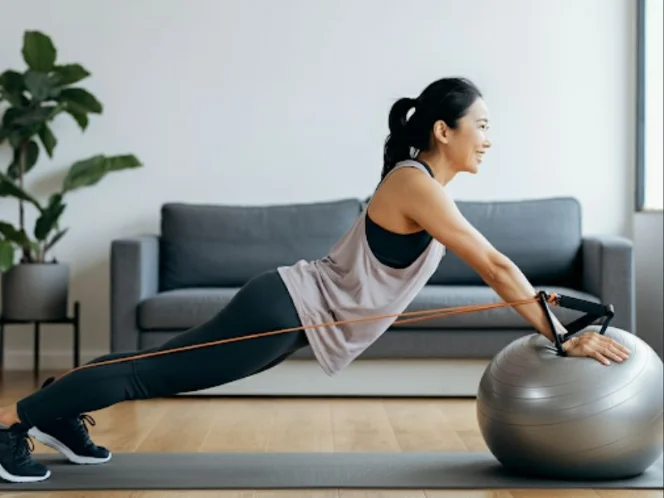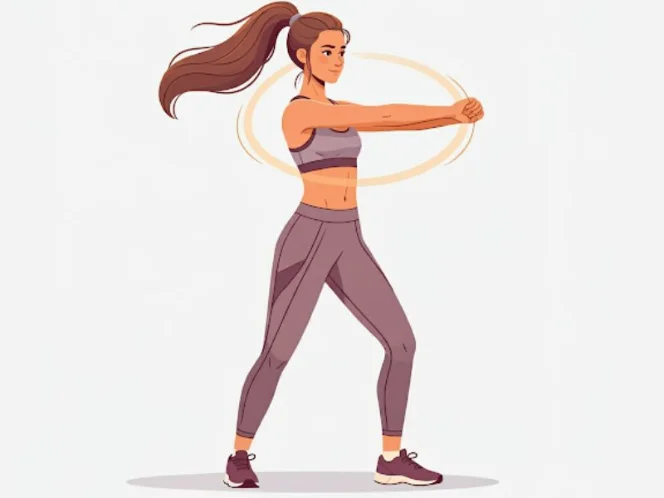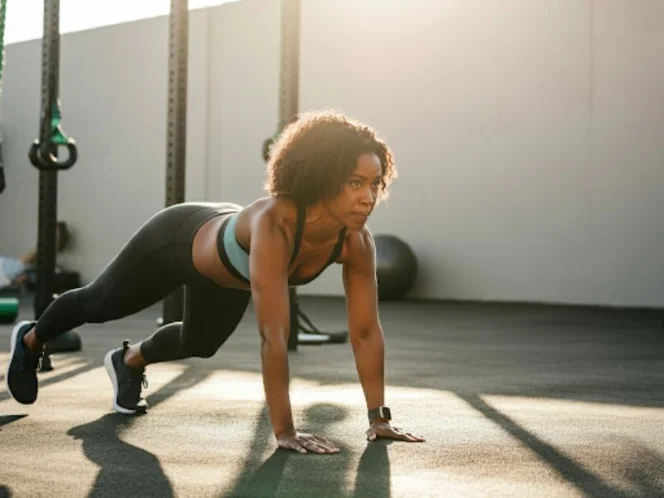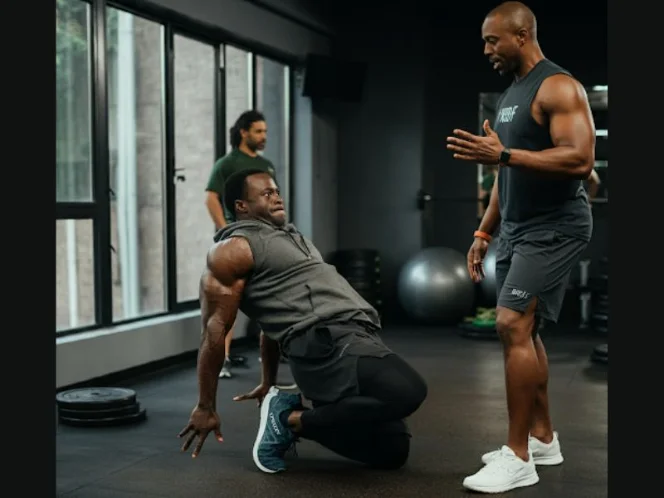Move Beyond the Gym: Train for Real Life!
Ever wished your workouts did more than just sculpt muscles? Imagine this: you effortlessly hoist a heavy suitcase into the overhead compartment, chase your kids around the park without getting winded, and conquer that challenging hiking trail with newfound strength and stamina. That’s the magic of functional fitness!

Functional Fitness: Your Body’s Everyday Superhero
Functional fitness isn’t about lifting the heaviest weights or running the fastest mile. It’s about training your body to excel at the movements you perform in your daily life. Think bending, lifting, twisting, pushing, pulling – all those actions that make up your everyday routine.
Why Functional Fitness Matters
Unlike traditional gym exercises that often isolate specific muscles, functional fitness focuses on integrated movements that engage multiple muscle groups simultaneously. This approach not only builds strength and endurance but also enhances coordination, balance, and flexibility, making you truly fit for life’s adventures.

Ready to Unleash Your Inner Athlete?
In this exploration of functional fitness, we’ll delve into its core principles, uncover its incredible benefits, and equip you with the knowledge to design a workout routine that optimizes your body for the real world. Get ready to move better, feel stronger, and live life to the fullest!

Core Functional Movements: Building Blocks for Everyday Life
Functional fitness revolves around training your body to perform essential movement patterns efficiently. These patterns mimic actions we commonly perform in our daily lives, such as squatting to pick something up, lunging to reach for an object, pushing a heavy door open, or pulling ourselves up onto a ledge. By mastering these core functional movements, you build a solid foundation for overall strength, stability, and mobility.
Squats: The King of Functional Exercises

The squat is a fundamental movement pattern that engages multiple muscle groups throughout your lower body, including your quads, hamstrings, glutes, and core. It mimics the action of sitting down and standing up, making it essential for everyday activities like getting in and out of a chair or picking up objects from the floor.
Proper squat form involves keeping your back straight, chest up, and feet shoulder-width apart. As you lower your hips, ensure your knees track over your toes and your weight remains evenly distributed. Squats can be performed with just your bodyweight or with added resistance using dumbbells, kettlebells, or barbells.
Lunges: Stepping Up Your Fitness

Lunges are another excellent functional exercise that challenges your balance, coordination, and lower body strength. They mimic the action of walking and stepping, making them beneficial for activities like climbing stairs, hiking, or simply navigating uneven terrain.
To perform a lunge, step forward with one leg, bending both knees to create two 90-degree angles. Keep your back straight and core engaged throughout the movement. Lunges can be performed in various directions – forward, backward, and laterally – to target different muscle groups.
Push-ups: Upper Body Powerhouse

Push-ups are a classic bodyweight exercise that builds upper body strength, particularly in your chest, shoulders, triceps, and core. They mimic the action of pushing objects away from your body, making them useful for activities like pushing open a heavy door or moving furniture.
Proper push-up form involves starting in a plank position with your hands shoulder-width apart and your body forming a straight line from head to heels. Lower your chest towards the floor, keeping your elbows tucked in, and then push back up to the starting position. Push-ups can be modified to suit different fitness levels by performing them on your knees or against a wall.
Pull-ups: Reaching New Heights

Pull-ups are a challenging yet highly effective exercise for building upper body and back strength. They mimic the action of pulling yourself up towards something, making them beneficial for activities like climbing a ladder or reaching for objects overhead.
To perform a pull-up, grip a bar with an overhand grip, slightly wider than shoulder-width apart. Hang from the bar with your arms fully extended, then pull yourself up until your chin clears the bar. Lower yourself back down with control. If you’re unable to perform a full pull-up, start with assisted variations using resistance bands or a pull-up machine.
Hinges (Deadlifts): Lifting with Power and Grace

Hinges, such as deadlifts, are essential functional movements that focus on hip extension and teach you how to lift objects safely and efficiently from the ground. They engage your posterior chain muscles, including your glutes, hamstrings, and lower back, making them crucial for activities like picking up heavy boxes or gardening.
Proper hinge form involves maintaining a flat back, engaging your core, and hinging at your hips while keeping your knees slightly bent. As you lower the weight towards the ground, keep it close to your body and avoid rounding your back. Deadlifts can be performed with various types of equipment, including barbells, dumbbells, and kettlebells.
Rotation: Core Strength and Stability

Rotational movements are essential for everyday activities like turning, reaching, and throwing. They engage your core muscles, which are responsible for stabilizing your spine and transferring power between your upper and lower body.
Exercises like Russian twists, wood chops, and medicine ball throws challenge your core stability and rotational strength. These movements are beneficial for activities like playing sports, carrying groceries, or simply navigating your daily life with ease.
By incorporating these core functional movements into your fitness routine, you’ll not only improve your overall strength and fitness but also enhance your ability to perform everyday activities with ease and confidence. Remember to focus on proper form and technique to maximize the benefits and minimize the risk of injury.
Your Functional Fitness FAQs
You’ve got questions about functional fitness, and we’ve got the answers! Let’s address some common queries to help you understand this dynamic approach to training and how it can benefit you.
Is functional fitness good for beginners?

Absolutely! Functional fitness is highly adaptable and can be modified to suit all fitness levels, including beginners. The key is to start with bodyweight exercises and gradually progress to more challenging variations as your strength and confidence improve.
For example, if you’re new to squats, you can start by practicing the movement with a chair behind you for support. As you get stronger, you can gradually lower yourself further and eventually perform full squats without assistance. Similarly, push-ups can be modified by performing them against a wall or on your knees. A qualified functional fitness trainer can help you tailor exercises to your current abilities and guide you on proper form.
What is the difference between functional fitness and CrossFit?

Functional fitness and CrossFit share some similarities, as both emphasize functional movements and high-intensity workouts. However, there are some key distinctions.
Functional fitness is a broader term encompassing any type of training that improves your ability to perform everyday activities. It can be adapted to various settings and individual needs. CrossFit, on the other hand, is a specific branded fitness program with a structured methodology and competitive element. It often involves high-intensity workouts with specific exercises and equipment, such as Olympic lifts and plyometric boxes.
While CrossFit can be a great way to improve functional fitness, it’s not the only option. You can incorporate functional movements into various workout styles, including bodyweight training, HIIT, and even yoga.
Can I do functional fitness at home?

Definitely! Functional fitness can be easily adapted to a home setting with minimal or no equipment. Many bodyweight exercises, such as squats, lunges, push-ups, and planks, are highly effective for building functional strength and can be performed anywhere.
You can also incorporate household items or affordable equipment like resistance bands, dumbbells, or a stability ball to add variety and challenge to your workouts. Numerous online resources and videos offer guided functional fitness routines you can follow at home.
How often should I do functional fitness workouts?

The ideal frequency for functional fitness workouts depends on your individual goals, fitness level, and recovery capacity.
As a general guideline, aim for at least two to three sessions per week, allowing for rest days in between to allow your body to recover. You can also incorporate functional movements into your daily activities, such as taking the stairs instead of the elevator or carrying your groceries instead of using a cart.
Listen to your body and adjust your training frequency and intensity as needed. Consistency is key for seeing progress and reaping the benefits of functional fitness.
Designing a Functional Fitness Program: Your Blueprint for Real-Life Strength

Creating a functional fitness program involves more than just randomly stringing together exercises. It requires thoughtful planning and a focus on movements that translate to real-life activities. By following a structured approach, you can ensure your workouts are effective, efficient, and tailored to your specific goals and needs.
Warm-up: Prime Your Body for Action

Before diving into your workout, it’s crucial to warm up your muscles and joints to prepare them for the demands of functional movements. Dynamic stretching, such as arm circles, leg swings, and torso twists, increases blood flow, improves range of motion, and activates key muscle groups. This helps to enhance performance and reduce the risk of injury.
In addition to dynamic stretching, incorporating light cardio, like jogging or jumping jacks, can further elevate your heart rate and prepare your body for the workout ahead. A proper warm-up should last around 5-10 minutes and leave you feeling energized and ready to move.
Workout: Embrace Functional Movement Patterns

The core of your functional fitness program lies in selecting exercises that target the fundamental movement patterns we discussed earlier: squats, lunges, pushes, pulls, hinges, and rotation.
Choose a variety of exercises that challenge different muscle groups and incorporate both bodyweight and weighted movements. For example, a workout might include squats, lunges, push-ups, pull-ups, rows, and planks. You can also use equipment like kettlebells, dumbbells, and resistance bands to add variety and increase the intensity.
Consider structuring your workout as a circuit, performing each exercise for a set number of repetitions or time, with minimal rest between exercises. This helps to elevate your heart rate and improve cardiovascular fitness while building strength and endurance.
Cool-down: Enhance Flexibility and Recovery

After your workout, it’s essential to cool down and allow your body to recover. Static stretching, where you hold each stretch for 15-30 seconds, helps to improve flexibility, reduce muscle soreness, and promote relaxation.
Focus on stretching the major muscle groups you worked during your workout, such as your hamstrings, quads, chest, and back. You can also incorporate foam rolling or self-massage to further release tension and promote recovery.
Progression: Gradual Overload for Continuous Improvement

To continue seeing progress and avoid plateaus, it’s essential to gradually increase the challenge of your workouts over time. This can be achieved through progressive overload, where you gradually increase the intensity, weight, or repetitions of your exercises.
For example, if you can comfortably perform 10 bodyweight squats, try adding weight or increasing the number of repetitions. You can also progress to more challenging variations of exercises, such as moving from assisted pull-ups to full pull-ups.
Remember to listen to your body and avoid pushing yourself too hard too soon. Gradual and consistent progress is key to achieving long-term success and avoiding injury.
Listen to Your Body: Rest and Recovery are Essential

While consistency is important, it’s equally crucial to prioritize rest and recovery. Adequate sleep, proper nutrition, and active recovery techniques like foam rolling or gentle stretching can help your body repair and rebuild after workouts.
Pay attention to any signs of overtraining, such as persistent muscle soreness, fatigue, or decreased performance. Don’t hesitate to take rest days when needed and adjust your training intensity based on how your body feels.
By incorporating these principles into your functional fitness program, you can create a sustainable and effective routine that helps you achieve your fitness goals and enhance your ability to perform everyday activities with ease and confidence. Remember to consult with a healthcare professional or certified trainer for personalized guidance and support.
Embrace Functional Fitness: Move Better, Live Better

As we’ve explored the world of functional fitness, it’s clear that this approach to training offers a wealth of benefits beyond aesthetics. By focusing on movements that mimic real-life activities, you build strength, stability, mobility, and coordination that translate to everyday life.
From mastering core functional movements like squats and lunges to understanding the importance of proper form and progression, you now have the tools to design a workout routine that optimizes your body for the real world. Remember the importance of warming up, cooling down, and listening to your body to ensure safe and effective training.
Whether you’re a seasoned athlete or just starting your fitness journey, functional fitness can empower you to move better, feel stronger, and live life to the fullest. So, ditch the isolated exercises and embrace functional movements that prepare you for anything life throws your way.
Your Next Step: Unleash Your Functional Potential

Ready to take action? Start by incorporating functional exercises into your current routine or explore dedicated functional fitness classes. Consider working with a certified functional fitness trainer who can assess your movement patterns, provide personalized guidance, and help you achieve your goals safely and effectively.
Embrace the power of functional fitness and unlock your true physical potential. You’ll not only transform your body but also enhance your ability to navigate everyday life with confidence and ease.




